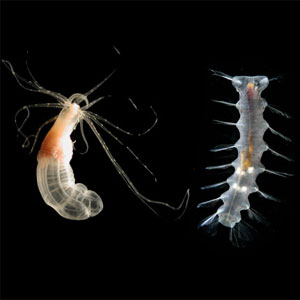« Prev Next »
 In today's podcast, Ilona speaks with Casey Dunn, Assistant Professor of Biology at Brown University, about student-created science videos. Casey is an invertebrate biologist, and with support from the NSF and Brown, he began a video project with his students called CreatureCast, a series of animated visual explanations of invertebrate animal behavior, evolution, and development. In the classroom, Casey has formalized this video creation to stand as a final project, and has found these assignments to be effective ways to assess learning and stimulate interest. Listen to this podcast to learn how Casey is able to transform the science report and open up creativity among students while keeping the focus on learning. [11:07]
In today's podcast, Ilona speaks with Casey Dunn, Assistant Professor of Biology at Brown University, about student-created science videos. Casey is an invertebrate biologist, and with support from the NSF and Brown, he began a video project with his students called CreatureCast, a series of animated visual explanations of invertebrate animal behavior, evolution, and development. In the classroom, Casey has formalized this video creation to stand as a final project, and has found these assignments to be effective ways to assess learning and stimulate interest. Listen to this podcast to learn how Casey is able to transform the science report and open up creativity among students while keeping the focus on learning. [11:07]
![]()

![]()
Full transcript
ILONA MIKO: Welcome to the latest edition of NatureEdCast by Nature Education. I'm Ilona Miko, and today we're talking to Casey Dunn, Assistant Professor of Biology at Brown University about science videos. Casey is an invertebrate biologist and an avid scuba diver who frequently travels to ocean depths for his field work. With support from the NSF and Brown University, Casey has begun a video project with his students called CreatureCast, a series of animated visual explanations of animal behavior, evolution, and development. Through his work, Casey has motivated students to submit final projects in the form of videos, an unusual medium for the science report. Along with his colleague, Steve Haddock, he is currently finishing a book called Practical Computing for Biologists. Welcome, Casey.
CASEY DUNN: Hi.
MIKO: Great you could join us today.
DUNN: Oh, I'm happy to. Thanks for the invitation.
MIKO: I understand you give your invertebrate zoology class an option for their final projects, either submit a final paper or make a video. Why do you give them the video option?
DUNN: I give them the video option in part because I'm interested in generating video content that can then be used in other classrooms as a teaching tool. But then also to encourage the students to go through the process of communicating what they've learned in the course, or what they've been inspired to pursue by some material in the course, to present the material in a different way.
MIKO: So do you think this enhances the textbook-style learning that we traditionally have in science classes?
DUNN: Yeah, it absolutely does. I think that one challenge of teaching organismal biology — whether you're teaching plants or animals or anything — is to make these organisms seem real if you haven't seen them before. So, they can seem quite abstract if you're just looking at the line drawings or the descriptions in the text. And in the case of the invertebrate zoology, I found that video is a very effective medium for really putting those organisms into the flesh.
MIKO: So do you think some students with different personalities or different strengths can benefit from these types of assignments over, say, a paper assignment?
DUNN: Yeah, absolutely. I provide the option just because I think that different students can get different things out of presenting the material in different ways. One reason I give the option too is I don't want to force everyone to produce a video, just because some students might be more inclined towards learning the production techniques and things that are required, and others would rather just focus on the content with more traditional media, such as a written paper or something. But it's nice, I think, to be able to provide the option to students that do have proficiency with the tools already or are interested in learning how to generate videos to present the content in that way as well.
MIKO: So that sounds really interesting. What are some of the challenges to making a video or making an assignment like this instructive so that it can actually have the formality and the gravitas that, say, a final paper would have?
DUNN: Yeah, actually I think that one of the biggest challenges with it isn't just to include the content and have relevant material. It's to make it cohesive. It's a very different challenge to make a video that holds together than it is to make a paper that holds together. So to really focus on the narrative storytelling in the video becomes very important. So it's almost more of an essentialist endeavor in a way: you really have to strip the story down to its bare pieces. You could communicate a lot in fewer words in a two- to five-minute video than you could in a four- to six-page paper. So, it becomes very important for the student to understand and get down to the core of the material that they're presenting.
MIKO: So it seems like they're going to be presenting some set of information in the video, but how can you as a teacher coach them along through the process?
DUNN: Yeah, so the key is to provide feedback throughout the entire process of putting together the video. So I give them feedback right from the start. So I have them pick a subject very early on and then we talk about how applicable that topic would be to a video. And if it doesn't look like it's well suited to a video but they still want to pursue it, then I would encourage them to write a paper about it instead. So, but if they come up with a topic that works with the video, then Sophia Tintori and I (Sophia is a producer on the CreatureCast project) coach the student on various things, such as simplifying the story, just listing the facts and their key to moving it along, and everything else that goes into making a video that is going to be enjoyable to watch and informative and —
MIKO: — Yeah, it seems like you have in some of the ones I've seen, that you have a lot of animation and a lot of illustration of moving animals, which I think is really fun — really fun for the student to be able to adapt to what they see into their own kind of creative visual format. But on sort of a more serious note, it seems like it's also kind of a training in communication for the students to really think in a very reductive way and then expand back out.
DUNN: Oh, absolutely, I think so. I mean, there's a real tendency — especially with invertebrate zoology or something where there's this whole new lexicon that goes with it (you're learning about all these organisms that you haven't seen before) — to just get lost in the minutiae, in the detail. But in order to make a video for the public audience, you really have to stand back and think about how you would explain this to your grandmother or someone else. And if you can explain these organisms or the concepts that you're interested in exploring in the context of these organisms to a public audience, then that also makes you a more effective communicator with scientific colleagues in the future as well.
MIKO: Oh, I see. So the audience for these videos is not just you and, say, the class. You have broader goals with these.
DUNN: Oh, absolutely. So that's the great thing now about video of course: it's an incredibly easy to distribute video now. So we make the videos, we have popcorn on the last day of class, and we all watch them together. And then we also post them. And in all the videos that we've put up, including the student videos, have now been watched over 100,000 times —
MIKO: — Wow, that's fantastic —
DUNN: — So these are reaching a wide audience. Yeah.
MIKO: So can you give us an example of a particularly effective video that came from this process?
DUNN: There's lots of great videos that have come out. Different videos have different strengths. So some people are focusing more on the presentation; others are focusing more on the organisms per se. One that jumps to mind is a video that Lee Stevens, a sophomore in the invertebrate zoology class, did last fall. And this was on how ctenophore, or comb jellies, move through the water. She had no production experience before — no animation experience and went and learned how to use [Adobe] Flash — and made a digital animation that just really pulled this together in a way that many different people could understand. It's free of jargon, it really gets to some interesting principles, and the production is just amazing. I mean, right down to the timing and all these things that can take quite a while to develop. So that was really fun to see her not only produce something that was scientifically informative, but was so effective production-wise.
MIKO: Yeah, it seemed (I saw the video) — and it seemed like she was doing a really good job of showing how locomotion in animals, from single-set organisms to a big animal like a comb jelly, is similar. So she was drawing these analogies and using a lot of visual metaphor to show that. It seemed very effective to me.
DUNN: Yeah, and in general I think that the animations are just highly effective for this kind of thing because so many of the principles that we're looking to communicate in the class — and this extends well beyond invertebrate zoology or organismal biology — are just inherently visual. And animation is a way to strip those visuals down to what is essential to conveying the particular ideas. Live-action video, like videos of organisms moving or something like that, can also be highly effective. But there's something that's very minimalist about the animations that is really nice. And the other thing is it's so easy now to produce animations with a variety of tools. So Lee had used Flash and done it all digitally, but other animations have been just hand-drawn animations or claymation. You can do something very simple and be quite effective.
MIKO: That sounds really successful. Do you think that your colleagues may be adapting some of your teaching techniques and do you think this kind of video assignment has potential for science learning for everyone?
DUNN: Oh, yeah, I think so. One thing that's nice is that you could apply this to all sorts of classrooms. And the other thing is that we've actually found as we've gone that the shorter the video is, the more effective it is in many ways. So this isn't a weeks- or month-long commitment to make a major motion feature film. You could just do something that's as short as thirty seconds or a minute that's highly effective. And you could do that in a day. And the other thing is that animation is a very forgiving medium in particular, and the nice thing about the animation is you don't have to have the organisms in the classroom to make the animation. You can work with other materials that are available. And we've certainly found that some of the rougher edges in the animations are the very things that give them character, and in some ways the more low-fi the animations are, the more endearing they can be in a way. And they can really grab people's attention, so —
MIKO: — So it doesn't have to be slick —
DUNN: — It does not have to be slick. But it —
MIKO: — But it's still memorable.
DUNN: Yeah. I mean, there's this funny thing. If you stick a person in front of a video camera — we're just somehow trained, we're used to soft, even lighting and high resolution and everything — it's really hard to make something that doesn't look schlocky if you're filming a person. But it you're making animation, it's just far more forgiving.
MIKO: Well, thanks for telling us about that today. I really think that's a cool way to bring together science concepts and challenge students while they learn how to communicate science. Thanks, Casey.
DUNN: Oh, it's my pleasure.
MIKO: Thank you for listening to this edition of NatureEdCast. You can find this podcast and others at nature.com/scitable. That's nature.com/s-c-i-t-a-b-l-e. Please join us again next time.






















